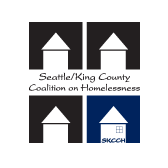Poetry zine gives voice to Sand Point Housing youth
The youth who live at Solid Ground’s Sand Point Housing campus do not see themselves as a continuation of their parents’ lives. “I get super annoyed when I am compared,” one girl says. “It’s just irritating because that is just saying that you don’t really know who I am if I am being compared.”
Thus the title COMPARED TO WHAT? was born for the zine that developed out of a writing and arts workshop series Solid Ground held last fall for the older teens living with their families at Sand Point, a neighborhood of 175 households at the old Naval Station of Puget Sound in Magnuson Park.
The workshops were based in the principle that everyone’s voice should be heard. Starting with writing sessions led by Seattle storyteller and educator Kathya Alexander, they continued with photography and design sessions led by Solid Ground staff. Through it all, young people found their voices. “Their growth was beautiful to see,” says Christina Shimizu, Annual Giving Officer at Solid Ground and one of the staff supporters of this youth-driven project.
Starting out with writing prompts and progressing to original poems helped the participants feel comfortable, not only with writing, but also with one another. Within this supportive group setting, the youth quickly gained confidence and began to share their personal experiences – an important outlet for previously homeless youth who have not had many opportunities to express themselves creatively.
One of the teens comments about the project, “This is the first time we are actually getting heard, with a different point of view. Our point of view. We think differently from the way adults think. We can also teach adults how we think, because our generation is so different than your guys’ generation. I feel like we know so much more.”
I am a rare solar eclipse
Gray and overlooked
A tough cactus
Midnight, calm and relaxing
I am needed like air
A glistening diamond
The illusion that the sky is blue”
 After a few writing sessions, Sand Point Case Manager and experienced photographer, Bellen Drake, led a photography workshop focused on visual aspects of the storytelling process. She spent a day with the youth taking photos and teaching them to use their cameras to capture the essence of their experiences, which for most is shaped by poverty-induced instability. Although most of the poets moved into long-term housing years ago and no longer identify as being homeless, Bellen notes that “it was a valuable opportunity to reflect on a time that impacted them as children, and they have now grown out of. It was a time in their past; homelessness is not their current situation.”
After a few writing sessions, Sand Point Case Manager and experienced photographer, Bellen Drake, led a photography workshop focused on visual aspects of the storytelling process. She spent a day with the youth taking photos and teaching them to use their cameras to capture the essence of their experiences, which for most is shaped by poverty-induced instability. Although most of the poets moved into long-term housing years ago and no longer identify as being homeless, Bellen notes that “it was a valuable opportunity to reflect on a time that impacted them as children, and they have now grown out of. It was a time in their past; homelessness is not their current situation.”
There were multiple leaders within the group and it was an entirely collaborative effort to put the zine together and publish it in January. The poems and images bring to mind the vividness of young romance and deep angst, mixed with materialistic egos and happy innocence. The young artists reveal their dreams and aspirations of growing up, as well as their multidimensional approach to discovering the answers to “What is Justice?”
COMPARED TO WHAT? showcases this unique community and amplifies voices that too often go unheard.
Our published writers & artists are: Ayanle Abdikadir (Abdi), Mohamed Abdikadir, Nya Rambang, Marie, Sahvannah Glenn, Maar Rambang, Heaven, Ryahnna, Geo, Chris Gainey, Ben Dessalegne, Jen Matapula, Andrea R, Deiosha Sparks.
To get your copy of Compared to What? or learn more about how you can support the youth at Sand Point Housing, contact Christina Shimizu at christinas@solid-ground.org.
Filed under: Youth | Tagged: artists, Brettler Family Place, homeless, Kathya Alexander, Magnuson Park, photography, poetry, Sand Point Housing, voices, writers, youth, zine | 2 Comments »




























